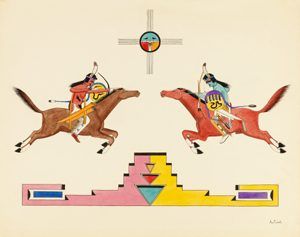

AWA TSIREH SERIES
federal government, which included sending Pueblo youths to boarding schools as well as attacks against ceremonial practices that culminated in a series of documents issued in the early 1920s (by Commissioner of the Office of Indian Affairs Charles Burke) restricting many of them.Īt this time, Pueblo potters-mostly women-began to produce less elaborate small pottery vessels and figurines so that they could maximize their sales to tourists. These sales also created room for Pueblo cultural expression in the face of the forced assimilation policy by the U.S. The sales of Indigenous hand-made objects for the non-Native market helped Pueblos to survive economically. in 1848 as a result of the Mexican-American War. Meanwhile, Pueblo communities needed to earn cash due to the reduction of the land available for agriculture and hunting due to the encroachment of Anglo and Hispanic ranchers seeking to increase their production of beef as well as the increased presence of a cash economy after New Mexico was annexed by the U.S. Along with the railroad run by Atchison, Topeka, and Santa Fe (AT & SF) Railway, Fred Harvey Company’s hotels sold Indigenous hand-made objects and set up demonstrations of ceremonial dances as well as the making of Indigenous arts like Pueblo pottery and Diné (Navajo) weavings.

As the result of railroad tourism in the American Southwest from the 1890s, Pueblo pottery became widely popular among white urban middle- and upper-middle-class individuals. The significant stylistic change from black-on-cream wares in San Ildefonso pottery around the turn of the twentieth century, and the invention of polished black-on-black wares in the late 1910s, were the result of Pueblo communities’ increased contact with U.S. Navaho Indians among them Elle, the most famous weaver among the Navahos, and Tom of Ganado, her husband, and Indians from other tribes-Santo Domingo, Isleta, Laguna, and San Felipi,” a postcard from the Fred Harvey series, c. Although he received accolades for his paintings throughout his lifetime, less is known about Awa. Born at San Ildefonso Pueblo in 1898, Awa Tsireh began his painting career in 1917 and by the early 1920s his work was exhibited nationally.

Modernist works by painters and photographers, including Marsden Hartley, John Marin, Georgia OKeeffe, Ansel Adams, Rebecca Strand, and Paul Strand, are featured alongside indigenous art that inspired their modernist sensibilitiesNative American painters like San Ildefonso Pueblos Awa Tsireh and Taos Pueblos Pop Chalee, whose work Mabel supported, and traditional Hispano devotional art collected by Luhan.\): “Indian work room, Indian Building, Albuquerque, New Mexico. This exhibit explores the paintings and metalworks of San Ildefonso artist Awa Tsireh (Alfonso Roybal). With Luhan as their hostess, these European and American talents found inspiration in the mesas, mountains, Hispanic villages, and Indian pueblos of northern New Mexico. Lawrence, Jean Toomer, Mary Austin, and Frank Waters choreographer Martha Graham and anthropologists Elsie Clews Parsons and John Collier. Luhan spent her adult life building utopian communities, first, as an expatriate in Florence (190512) working to recreate the Renaissance next as a New Woman in Greenwich Village (191215), hosting one of the most famous salons in American history and finally, in Taos, the New World (191847), bringing together a community of artists, writers, and social reformers including writers D.

Mabel Dodge Luhan (18791962) was a political, social, and cultural visionary salon hostess and collector of genius in almost every field of modernismpainting, photography, drama, psychology, radical politics, social reform, and Native American rights.


 0 kommentar(er)
0 kommentar(er)
